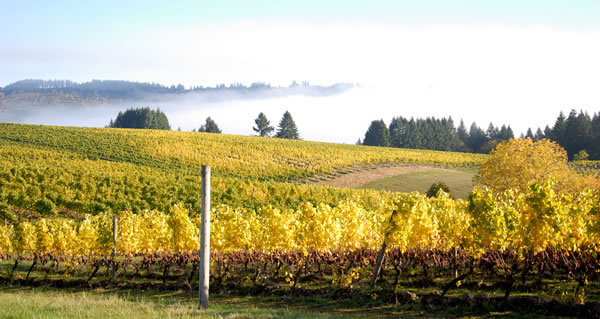We are 90ish% complete with harvest, with only Riesling and 5 tons of Pinot noir smidgens to pick. We began picking young Chardonnay October 18th, Pinot noir Oct 24th thru Nov 2nd (still a bit to come) and expect to hold Riesling until mid-to end of next week, Nov 8-10th or so.
The vintage is THE latest harvest on my records, with a 5-day later start than even 2010 but not much different in profile. I’ve attached a file that shows the picking distribution over time for the last 15 vintages for our vineyards, for PN and for all varieties.
The 2011 vintage differs somewhat in that the short crop saw a severe intentional green harvesting like 2010, but without the additional bird-plague of 2010. The 2011 vintage significantly showed a great ripening season heat ramp-up, the best of the last 15 years, and the most needed in all these vintages. It was very far behind anything we’d seen in heat units until the Sept-Oct months, when it surged. The attached table of degree-days shows the intervals and how much 2011 packed on compared to the last 15 years. The cumulative degree days for 2011 eventually bested both 2010 and 2008.
Rain was reduced in 2011 to below average for both October and for September-October, which helped fruit quality. We had a little botrytis from the Dundee Hills, but NONE at the other three sites, thanks to generally reduced rain in 2011, to being less ripe during a 14 day early October period where minor rain daily built 1.88 inches in total, and to very good spray program preparation with wide open fruiting zones. See the attached table for rain over the last 15 years.
The cool nature of the vintage for Pinot noir means low sugars and low pHs, with acids very nice but not screechy. Sugars are ranging from 21-23 brix (averaging 21.9) and pHs 3.10-3.30 (3.19 average), with titratable acids of 6.3-8.1 (averaging 7.0). Colors at this point seem very good thanks to the long season and adequate heat for polyphenolic development.
If we consider the key factors of (1) late season harvest, (2) lower yields and (3) below average rainfall, most vintages exhibit some of the factors, but only three vintages of the last 15 exhibit all three factors: 1999, 2008 and 2011. This is obviously premature if used to assert great quality to 2011, but is an interesting premise. Early harvests can affect hangtime and harvest temperatures, higher tonnage reduces intensity, and rain late both dilutes juices and, most importantly, encourages botrytis with its impact on fruit character and color (polyphenoloxidase impacts).
In conclusion, I’m very encouraged by what we see at this stage with all but Riesling in the house, with very little water on anything, with long hangtimes, with low but adequate sugars/low alcohols, and with finally complete flavors balanced by moderate acids and very low pHs. As self-serving and worthy of skepticism as it undoubtedly seems, I DO liken this vintage most to 1999 and 2008 in recent years (throw in 1993 if you want to go back aways). It will be an excellent vintage.
Regards,
Harry
Weather and Its Implications
We’ve gotten almost as much latitude from Mother Nature as we could ask for. We brought in the last major Ridgecrest lots of Pinot gris and Pinot noir plus the last mid-hill Pinot noir from Corral Creek Wednesday, all with less than 0.4 inch of rain in more than 3 weeks of final ripening, and therefore, all with virtually NO botrytis. And NO birds.
Friday saw us harvest Gruner veltliner on the same day as last year, this time with sub-freezing temperatures and heavy fogs, which have been with us after the clear nights of this dry period. All told, 100 tons in five days, processing from 8AM to 11PM or so.
Hardy Riesling remains and will gain more hangtime before picking in 5 or 6 days.

0 Comments
Leave A Comment